| FAQs on Parasitic Marine Worm Diseases: Flukes/Digenes & (Monogene)
Trematodes: Diagnosis, Symptomology
FAQs on:
Flukes/Trematodes 1,
Flukes/Trematodes 2,
Flukes/Trematodes 3,
Flukes/Trematodes 4,
FAQs on Flukes/Trematodes:
Etiology/Prevention,
Treatments That Don't Work,
Cures That Do Work,
Products/Manufacturers;
Case Histories
Related Articles:
The Flatworms That Are Flukes
by Bob Fenner, Marine Parasitic Disease,
Parasitic Worms,
Roundworms,
Related FAQs:
Fish Worm Diseases 1, Marine Worm Parasites 2,
Marine Worm Parasites 3, & FAQs
on Marine Worm Parasites: Diagnosis/Symptomology, Etiology/Prevention, Cures That Don't Work, Cures That Do Work,
Products/Manufacturers...
Tapeworms/Cestodes,
Leeches/Hirudineans,
"Other" Worms and Worm-Like Parasites...
Paravortex/Black Spot Disease,
De-worming Medicines, |
Cloudy eyes, frayed fins, labored rapid breathing... appearance of Flukes
themselves; particularly under a microscope or following a treatment
bath/dip (having fallen off)
|
Are you able to tell me what this is?
9/6/18
I quarantine my fish and have had pretty good luck in keeping my fish healthy
and happy. Unfortunately, last Feb I had something show up in the tank. It
started with my male trigger, then moved onto my female trigger and the other
big fish in my tank (a few tangs and a Foxface). It didn't seem to affect my
smaller fish (dwarf angels, baby tangs, clownfish etc.)
<Mmm>
I pulled everything out and into a quarantine system, where they have remained
since. I did lose a few of my bigger fish, but luckily that's where the losses
ended. I decided to keep my main display fallow until mid
November in hopes that whatever this is, it will have a cycle that is
host-reliant.
I've never seen any evidence of Ich or velvet. The exit wounds were rather
large, and ultimately the fish that died had secondary bacterial infections
which may have been the cause of their demise.
I have attached a video of what it looked like in hopes that you can shed
light on it so I know how best to ensure that it doesn't come back and kill
anymore livestock.
https://youtu.be/kmv89eQkxYE
<I see the white growths on your Trigger. These look like monogenetic
Trematodes. Do you have a low power scope that hooks up to a USB port? I'd
like to see a sample closer. Alternatively this could be some sort of
Microsporidean infestation. The worms are easy to treat (see WWM), the
Protozoans, not>
Thanks in advance for your assistance.
Cheers,
Angela
<Thank you for sharing. Bob Fenner>
Fluke 5/18/16
Hey,
I don't know if you guys can help or give advice on this but your
website is the best clue I've found so far to my problem.
I found the closest picture to what I found on my regal tang and
butterfly fish on one of your message boards and I read through it to
see if anyone mentioned the name but there didn't.
<The image... lifted? Is the opisthaptor of a Monogene....>
I was wondering if anyone could help me identifying this parasite.
<.... on the basis of what?>
The fish were showing hazy eyes, shaking of the head, lethargy and
scratching off rock. We did a freshwater dip and the flukes came out
into the treatment tank.
<I'd add a bit of formalin... See the dip/bath S.O.P. on WWM>
I would like to figure out a treatment to clear the system but we have
lps in the tank so quarantine is I think the only option for the fish.
<See.... READ on WWM re Monogenetic Trematode/Fluke treatments....>
If I could identify the species I could learn more about its life cycle
and try break it to rid the tank of it completely.
Thanks,
Brona
<Need data mate. This isn't time for a guessing game. Bob Fenner>
Sent by iPhone
<READ> |
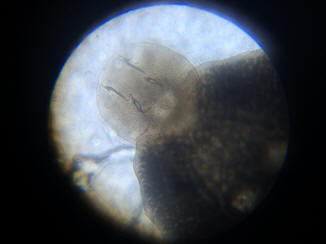 |
Re: Fluke 5/18/16
Hey,
That image I sent was taken of the parasites that came off my butterfly fish
after we did the dip, not lifted it was taken on my own microscope at home.
<Ah good. Will post then>
It was just similar to the picture I saw on your message board.
<Sorry for my misunderstanding your msg.>
What sort of data would be needed other than the image of the parasite and I
can let you know ?
<What other life, livestock present. Do you have live rock, sand? Have you
used Anthelminthics, Vermifuges already?>
Thanks
<Thank you. BobF>Re: Fluke
5/19/16
We have 3 Banggai cardinals, regal tang, bristle tooth tang, two clowns, 6 line
wrasse, cleaner wrasse. Love rock and live sand.
<Due to these last two, I would be very careful of using de-worming medicines in
this system. There are food-lacing techniques that may be worthwhile to try...
These are gone over, archived on WWM. Do you consider that most all the flukes
were removed from the tang and BF by your dip procedure?>
Lps corals, gorgonians and snakelocks anemone and beadlet anemone. Haven't
treated the tank due to corals and the fluke treatment available in shops here
aren't reef safe.
<There are none that are both safe and effective>
We have set up quarantine tank to take the fish out of main system and starve
the parasites.
<Ahh; good>
I have identified the parasite to the genus Neobenedenia.
<Quite common>
I am lucky enough to have access to large amount of research through university
libraries so I finally found some good papers about them and life cycle. Fresh
water dipping
<pH adjusted, and w/ the formalin.... Read here:
http://www.wetwebmedia.com/dips_baths.htm
and the linked files above re this biocide>
everyone before quarantine and going to starve the main tank parasite population
for a month to be sure and then reintroduce the butterfly alone for monitoring
to insure it's clean before releasing all the rest. We believe it was the
butterfly that brought it in as she is newest fish and supposedly they are
notorious with this parasite.
<Yes indeed. Thank you for sharing. Bob Fenner>
|
Cupramine leeching
7/30/15
Hello almighty saltwater gods. I am not worthy. So I was thinking.....what kinds
of materials and what nots can hold Cupramine in a tank and cause the testing
level to appear not to rise and/or then possibly leech back into the water when
conditions change?
<Oh; this list is long... am sure one could use the Net, but am so olde that I'd
be looking in a CRC Manual for common molecules likely to form in a marine
aquarium habitat. Is cupric chloride, copper carbonate have a higher solubility
product constant?>
For example, small clay pots, while they make nice caves, are porous. And can
bits of uneaten food soak the medicine up enough to cause a problem?
<Mmm; not as much as the seawater itself, or "fresher" carbonate substrate and
rock.... fired clay pots are somewhat chemically inert>
I know to remove uneaten food but I was thinking about using a seaweed clip and
in that case, the food would spend more time in the water than flakes or Mysis.
My bicolor blenny, usually fat and happy, is eating little.
<?>
I am currently having what seems to be a bit of trouble getting my Cupramine
level above 3ish. All of my parameters are good and I only have a pre seeded
filter, heater, two little clay pots and an airs stone in a bare bottom 20 long.
I am treated a bicolor blenny and a royal gramma. I have been slowly raising the
Cupramine level over the last week and I want to be sure I am at a good
therapeutic level so I'm not wasting my time and unnecessarily stressing my
fish. Also, I don't want to prolong their Ich misery. It is/was a slight case to
my eyes. I did not follow the directions, dosing wise, because I have read it is
better to slowly raise the Cupramine level, especially for the sensitive blenny.
Since the white spots, of which there were only two on the blenny's top fin, and
one on the gramma' head, are not the actual parasite themselves, is their
absence after or during treatment even a fairly reliable sign that treatment is
working? Shouldn't the spots disappearing mean nothing more than the human
equivalent of a scab falling off?
<Mmm; these spots may be from irritation of some sort... mucus accumulating....
Even Trematodes (seeing them btw very commonly here in Curacao the last week
diving>
I have read that Cupramine may kill Ich at levels as low as .25 but I don't want
to take the chance of under treating,
<Ah yes; and deep-embedded parasites, ones on fishes w/ thick mucus; even some
"Crypt ""races" can be resistant to copper exposure>
particularly since my bicolor has not been eating well. I think he should be ok
eating only a little so long as I can complete the treatment in a reasonable
amount of time, say three weeks total. I am using a SeaChem test. My ammonia is
good and I have been doing 20% water changes every three days, matching the
temp, ph, SG, and Cupramine level in the new water with that of the tank prior
to adding.
<Should test and replace the copper every day>
Besides that, the tank was fully cycled prior to treatment. I will remove
Cupramine after treatment and let my tank remain fallow for 72 days total.
Thanks again.
<I and you very likely appreciate the vagaries of copper use... Hence my
swerving allegiance to Quinine compounds (and always prevention via dips/baths,
careful livestock selection, optimized, stable environment, good nutrition....)
over recent years. Bob Fenner>
Re: Cupramine leeching... plus copy f'/Trematodes
8/3/15
Thanks again. My question regarding the seaweed clip....what I should have said
was...Will the seaweed absorb the Cupramine and then maybe leech back into the
water?
<It will absorb and re-lease very little copper. Not a worry. Again; there is
some cupric ion in all life.... it, the element is an essential, albeit "micro"
nutrient>
But before I read your reply I began to realize that my babies probably don't
have ich at all. I think you are right about this being a case of Trematodes. My
blenny's two fin spots have never changed location, only changed a bit in shape.
I think I assumed ich mostly because of the scratching both fish were doing
before I hospitalized them.
<Ahh! Saw a BUNCH of Flukes on fishes last week in Curacao.... more on more
species than I've ever encountered in the wild. Tellingly, much more prevalent
on fishes resident in some "environmentally modified" (polluted) locations>
I don't ask questions I don't want the answer to...so I will, in the future, use
a quinine compound with good aeration as you suggest.
<Heeeeee!>
But......since I have been putting them through two weeks of Cupramine already,
I think I will continue the course at least another week as a preventative
measure (unless, of course, you tell me to do otherwise). I think it would still
be wise to leave my display tank fallow for 72 days since I can't be sure ich
isn't there somewhere.
<Well; not to bum you out, and ignore your self-admonition above, but Crypt is
to degrees most every where there are tropical marine fishes>
After the Cupramine treatment is over, I think I should remove the Cupramine and
dose PraziPro?
<Sure; or could do now. The two compounds as "mix-able">
Does a freshwater bath fit into this equation at some point? I have a bicolor
blenny and a royal gramma.
<Better a FW bath, pH adjusted w/ formalin and aeration... see WWM re such SOPs
and their specific use in eradicating external Trematodes>
Interesting that you saw an increase in Trematodes in the wild as I don't
believe I have ever dealt with this pest in the last 15 years of fish keeping.
<Mmm; very common on (imported) angels, butterflies, tangs..... sharks>
I've dealt with ich before, and the spots always visibly disappeared after a
couple of days in copper. I think I blamed my poor little clay pots for
rendering my Cupramine ineffective, but all along,
<I have used hundreds of gallons of this fine product in commercial settings. It
does precipitate (disappear) by about half every day... interacting with natural
and synthetic seawater... MUCH more so if carbonaceous substrate/s is/are
present. HAS to be assessed (tested for) and "topped up" daily or more often>
I misdiagnosed my problem. The lesson is always the same.....quarantine.
Thanks for your wealth of information and patience.
<A pleasure to relate/share. Bob Fenner>
Re: Marine Velvet / Ich and
Chloroquine/Hypo Treatment 6/6/14
Hi Bob,
<Brad>
I've attached a video I recorded from my microscope of some skin/gill
scrapings. To be honest I'm not sure if anything looks like what I see
in reference books. The video is shot with a 40x lenses and the USB
eyepiece is 10x. At 100 or 200x I can't see anything moving, but at 400x
I can see all sorts of activity. I'm not sure if this is parasites or
just bacteria and microfauna instead?
<Too big to be bacteria...>
There is one larger object which appears to be alive and moving, but not
sure if that might be a fluke?
<Might be... I think I see a haptor...
Video linked here:>
I don't see anything that looks like Velvet or Ich.
<Me neither>
If you have any guidance on what this might be (if anything (I'd
appreciate it) or if you want me to take a different type of sample let
me know. I do have a staining kit and oil immersion, just haven't done
much of this before.
Best Regards,
Brad
<Google: Trematode haptor... B>
Re: Marine Velvet / Ich and Chloroquine/Hypo Treatment
6/7/14
Thanks Bob!
<Welcome>
I'm going to try to catch some other fish and see if I can take some
additional slides to check if I see any similar critters on other fish,
or if it was just unique. That said, do you think that this warrants any
treatment e.g. Praziquantel in the DT or removing them entirely for
treatment--or is this harmless? Still researching what others say about
it's harm/treatment.
<There is/are some invertebrate group/s that are affected negatively....
OTOH, nice to get rid of Flukes off host as well. IF not to much
"trouble", I'd catch all fishes; treat in isolation; allow the
main/display to go fallow for a couple weeks>
I started removing the Chloroquine from the tank since it's been in
there for about 6 weeks now and I don't see any ick/velvet. Gonna keep
the tank at hypo levels for now to make sure that I don't see any
resurgence of other parasites. I'm wondering the Chloroquine was the
culprit on starting to fray the fins on a few fish since I had it
present for so long.
<Could well be. You can see this implication on the archived accounts of
CP use on WWM>
Thanks much as always!
Best Regards,
Brad
<And you; B>
|
Fluke surviving Muelleri Butterflyfish in QT with bacterial
infections (?) 10/13/13
Greetings,
<Good eve Sarah>
A friend of mine recommended you with the highest regard. I've
attached a cell phone picture (I don't have a regular camera, sorry) of
the affected area on my Butterflyfish. I've had him 15 months, he
eats live blackworms and a homemade frozen seafood blend.
Parameters are good in the quarantine.
The photo: Below the glare line in the middle brown stripe the lesion
like area is visible. There is some redness, the scales are raised,
inflammation is visible from the profile view and there are a couple
white apparatus' attached next to the inflammation. The white apparatus
will begin small and hard like, very bright white and after a couple
days grows larger and more flesh like, hangs off the fish (can visibly
see it moving as he swims) and then falls off. Above the glare line is
an example of one that can be seen moving in the current as the fish
swims. A 5 min fw dip didn't seem to affect the area.
<... have you looked at this material under a 'scope?>
I dosed Kanamycin into the water 2 days ago, also have been feeding in
frozen food. It seems too early to know if it's working.
Currently, the fish is eating, but hiding in his pvc most of the
time.
Additionally, he had a lower jaw (inside the mouth) infection that is
now reoccurring.
Thank you for your time.
Sincerely,
Sarah
<I suspect the white material is simply "mucus" (body slime)... an
exudate... from...? Not curable w/ antibiotics, nor
quarantine/isolation.
Do you suspect there is a parasite here? I would move this fish back to
the main/display system. Bob Fenner>
|
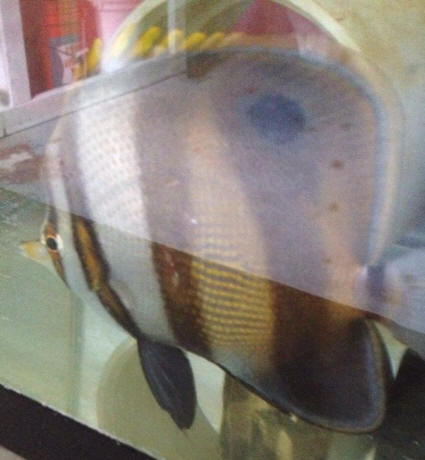 |
|
Re: Fluke surviving Mueller Butterflyfish in QT
with bacterial infections (?) 10/14/13
Thank you, Bob. I've been actively looking for someone to look under a
'scope, although, I'm concerned about increasing the fish's stress level as
he's been in hiding except for feeding time for several days.
<You are wise here... life is indeed "a series of compromises", and you are
right to consider the trade-off in handling this (or any) specimen>
This fish has undergone 17 days Praziquantel treatment (unsuccessful)
followed by 23 days Formalin, which I believe, effectively eliminated the
flukes.
<... am very surprised it didn't eliminate the fish>
I feel the lesions/mouth infection are some sort of secondary ailment - i
have read flukes are like portals for other diseases.
<Can be>
I do not know if there's some sort of parasite at this time.
<Highly unlikely... grossly appears to be "sores"...>
The fish's name is Ziggy.
<"Ziggy played guitarrrrrrrr" Bowie>
I appreciate your time.
Sarah
<And I everyone's. BobF>
|
Re: Microscopic images
9/2/13
Bob,
Here's more images.
<Some neat ones; 50, 13, and 12 are flukes... the last for sure; showing the
opisthaptor. 59, 60... some sort of crustacean; maybe an amphipod judging
from the legs... 79 and 81 are skin cells (and a color/chromatophore)... on
a ctenoid scale (you can see the serrated edge downward in this view)
I was wondering if you happen to see any information on the new research
into garlic extract (Allium) being effective in controlling Neobenedenia
eggs?
<Not in recent times; but I haven't been searching for it/this. I'd take a
look on a large database. See WWM re doing such searches. Bob Fenner>
Jennifer |
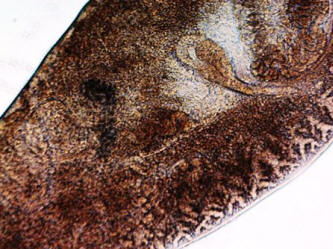
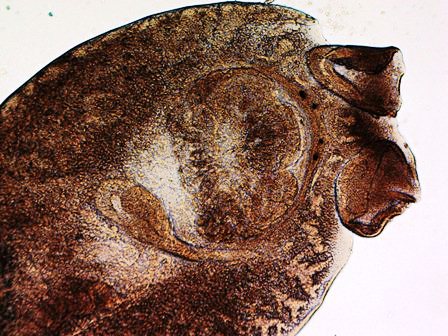
Oh yes... Fluke
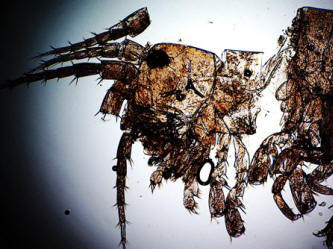
Crustacean; amphipod?
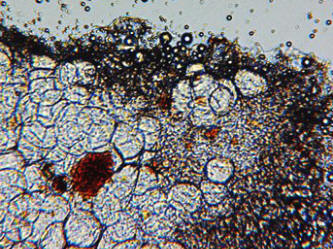
/Amphipods/PICT0081%20skin%20cells%20ctenoid%20scale.jpg)
Scale, skin cells, chromatophore |
Re: Microscopic images, Fluke ID,
treatment input
9/2/13
Thanks Bob for the great feedback! I do have more images but they are
on my microscope. The fluke I identified as Neobenedenia girellae.
<May be>
I could be off base on that. I've been dealing with this
fluke since March mostly using PraziPro to no avail. I came across research
from China stating that Praziquantel is not as effective against this
species of flukes as others.
<Interesting. There are other Anthelminthics... as you likely are aware>
This led me to new research (published in August) stating the
effectiveness of garlic extract and Asaragopsis taxicormis against marine
flukes. They are both very interesting reads. Albeit preliminary perhaps
promising.
Thanks again for identifying these images!! Oh and feel free to use them if
the need arises.
Jen
<Ah, thank you. Bob Fenner>
Re: Microscopic images 9/2/13
I am aware of other Anthelminthics, however, most are harder on the fish
than PraziPro. Are there any that you would recommend?
Jen
<Mmm, best to refer you to what is posted/archived on WWM; and maybe one
ref.:
http://www.int-res.com/articles/dao/10/d010p039.pdf
Bob Fenner>
Re: Microscopic images 9/3/13
Very interesting article!! Thank you:)
Jen
<Welcome! Bob> |
Flame angel scratching; flukes f' 8/19/13
Hi crew! I have a Flame Angel in a QT that sometimes hangs out
under the HOB filter flow and was scratching against the tank
bottom. What could be causing this?
<A few possibilities; something to do w/ "water quality", just an itch,
possible parasitic infestation are the big three likelihoods>
Let me give some info first. We've been fighting flukes
for almost 2 months.
<Mmm, a lean toward the first poss. then>
I've used PraziPro utilizing various protocols which I can give you if
needed but the end result has been the same. I used hypo salinity as
outlined by B.K. Diggles in the abstract of marine monogea. I finally
did a formalin dip last Monday and put into a new tank. I've
watched him all week and no scratching. I began increasing the
salinity <actually spg> to introduce him back into the main tank.
<No more than a 0.001/thousandth per day>
On Sunday I saw him scratching on the tank bottom.
<So? May be nothing>
I prepared a FW dip in a black bucket and dipped him for 5 minutes. No
flukes that I could find utilizing a microscope.
<Likely aren't any>
As for hanging out under the filter he lays on his side like he's trying
to knock something off. Otherwise his color has come back.
<Ah good>
His face was faded for nearly 2 months. He eats like a pig.
<Also>
Am I just being paranoid or did the formalin dip (20 minutes) not do the
trick?
<Already stated>
Please let me know if you need other information. Thank you! Jen
<Cheers, and I'd do nothing further. Bob Fenner>
Re: Flame angel scratching
8/19/13
Hi Bob! Thanks for getting ack so quick! In response to water quality I
have an ammonia badge
<Mmm, I don't trust these...>
on the QT which has registered 0 but he was acting hyper on Friday so I
checked the ammonia and it was at .25. I did 2 50% water changes to get
down to 0. The ammonia started creeping back up Saturday so I did
another water change. Could this cause him to scratch?
<Oh yes>
I've read salinity can be increased as much as .02 in 24 hrs
<No! MUCH easier "going the other direction", but it should not be
raised... as just stated... more than a thousandth a day>
so that is what I was doing. Could that cause scratching?
<... yes>
I am, however, heeding your advice and increasing by .01.
<You're missing a zero... perhaps a short read on significant figures...
Wiki>
I've been dealing with flukes off and on since March and it's getting
old.
Thank again! Jen
<Another welcome. B>
<<RMF is now wondering "if" Jen IS spkg. of salinity, NOT spg...>>
Re: Flame angel scratching
8/20/13
Mmmm, yep I don't trust them either. Ok, good to know that both of these
can cause scratching. What about him lying sideways under the HOB water
flow? No need for reading on significant figures...just was in a
hurry and not paying attention:)
Thank you for answering all these questions! Jen
<Nothing odd re the hiding... due to handling et al... The fish will
soon become more outgoing. B>
Re: Flame angel scratching
8/20/13
Oh, he's outgoing!!:) I can't walk by the room without him flying
out from behind his PVC to beg for food. He's been in a QT since June.
He contracted Brooklynella from an unquarantined sea urchin. We
beat Brook via a series of formalin dips. It's a long story how he got
flukes.
I will begin raising the salinity per your directions. Thank you kind
sir:)
Jen
<Most welcome Jen. BobF>
Powder blue tang 4/8/13
Hello all. My powder blue tang has what looks like small white
threads on one of its eyes.
<Ahh, likely Trematodes... Flukes>
Tried to get a pic but to no avail. Tank info - 125 gal, 100 lb live
rock, ammonia, nitrite, nitrate all 0 - ph 8.3, temp 77 degrees. Fish in
tank - yellow tang, clown, flasher wrasse, royal gramma, lawnmower
Benny, red Hawkfish, long-nosed Hawkfish (all get along fine). Any
thoughts?
Diann Trapp
<Search WWM re. Bob Fenner>
Re: Powder blue tang 4/8/13
Thanks, any suggestions as to what to do? He's eating like crazy and
acting normal. Should I be concerned about other fish?
<... please read where you've been referred. BobF>
|
Re: Fowlr health, myst. SW losses
6/10/12
Bob, I have had Moorish idols for years. I have been really lucky. For
some reason All the fish I get seem really healthy then there colors
fades and they die. I just lost a starry blenny, and Naso tang, to
the same thing.
<Mmm, as you have speculated... "something" is either missing that's
essential and/or "something" chronically toxic is being released,
generated in situ>
I do weekly water changes, I vacuumed my sand, I check all my levels,
clean out on my skimmer every few days. I can not figure out what is
killing these fish. This has been a problem for about two months now. I
added a nitrate, and carbon reactor. All levels are zero and where they
need to be. I am soooo lost and frustrated. Its like my water is
poisoned.
I even had that checked. Please help, Jim
<... wish I could help... W/o knowing the cause, there is not likely a
cure/solution coming... the usual complexing of the environment (making
it larger, more biota filled, having a large DSB) optimizing water
quality (via Ozone, RDP refugium...)... are about all I can/would
suggest. BobF>
FW: Fowlr health
Bob, I also wanted to let you know that few months ago I added rock and
sand. The sand was new out of bag, and the rock came out of a sump. At
the same time I had 400 watt medal halides that I sold. I switch to vho
super actinic. When I did all this my tank started crashing and has not
recovered. There brown hair algae on the rocks and the back of glass.
Today I found my powder blue, and brown tang dead. Jim
<No fun. B>
FW: Fowlr health 6/10/12
Bob, Sorry about the forwards. I pulled all my fish out for 30days.
<So I've read. I'm the person who parses all on WWM>
I thought that would take care of Ick that I had before. I decided I am
going treat the whole system with copper. There is some kind of parasite
in there and I think this my last option. I wanted to know if I need to
turn off my nitrate reactor when treating with copper?
<No sense just blindly treating a system... esp. w/ something as toxic
as Cu. B>
Re: Fowlr health – 06/14/12
Bob, Since treating my system. My Moorish idol got all his color back,
and is back to his normal aggressive self. Everybody seems to be doing
better.
I discovered one of my major problems going on with the tank. I don't
have a chiller and my tank runs about 80 during the day and drops to
about 74 at night.
<Too much variance>
See the problem. I am hoping that is what's been stressing everybody
out, but I don't know. I got my heater set at 80 now so the temperature
stays constant. So far everybody has been fine and ick spot free. I
moved my Naso, dwarf lion and snowflake eel to my quarantine tank. That
was a battle alone. i was doing 50% water changes because the tank had
not finish cycling. High nitrites and ammonia. Ammonia, nitrate, nitrite
is zero now, but there still stressed and not eating. S.g. 1.022 and
needs to check pH.
Jim
<Ok. B>
Re: Fowlr health 7/9/12
Bob, I looked up Trematodes. The story Parasite Help... and I mean HELP!
Trematode plus infested lg. SW sys. 7/10/07. It sounds a
lot like I got going on with my tank.
<... needs to be confirmed via microscopic...>
The emperors eye has not got any worse or better. I freshwater dipped the
niger. Unfortunally when I caught him I got a bunch of sand in the net. So I
could not see what came off him. I was thinking of PraziPro my tank, but
there is still .50 ppm of copper in there. If I put the PraziPro in there
will it poison them with the copper?
<Will not. These can be mixed>
I keep my water quality perfect, so I don't know if it could be a bacteria
infection. Jim
<Mmm, BobF>
Re: Fowlr health 7/9/12
Bob, My emperor angel has got pop eye. He got a big bubble over his eye. My
tank is crashing again.
<May be time to "bleach, do over">
I tried to do everything right. I don't know what to do now.
<Call in some local qualified help to look over your system, water, MO>
I look up this link and there is not a article there.
http://www.wetwebmedia.com/pop-eye.htm I think I am not smart enough
for this hobby. Lost in Idaho. Jim
<B>
Re: Fowlr health 7/9/12
I also wanted to add these pictures of my powder brown tang. He has had
these marks on his fins for a few weeks now. He also has a scratch right
past his fin. I am hoping this well help answer some questions. Sorry
for so many emails Bob. Jim
<... my opinion has not changed since I began reading of your system's
issues... There is something toxic present here... pathogenic; I don't think
so... but could have been introduced along the way... in addn. to the
toxicity. Have you tried PolyFilter in the filter flow path? Was there a
color to the pad/s? B>
|
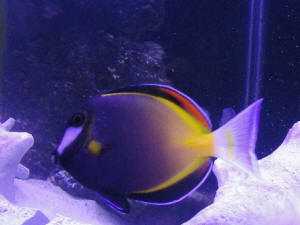
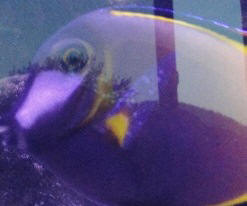 |
|
Re: Fowlr health MIRACLES IN IDAHO 7/10/12
Bob, It was a good day. Yesterday after I freshwater dipped my niger. I
thought it was the last time that I was going to see him alive. I came
home from work and he was swimming around!
<Ahh!>
One eye was clear and the other had one little speck on it. So I
freshwater dipped the Emperor. He looked as bad as the niger did
yesterday.
There had to be over 200 rice looking things exploding out of his gills.
<Interesting>
So it was flukes! I treated my tank with PraziPro today. I turned off
skimmer, charcoal reactor, and nitrate reactor. I am going to drop my
feedings to once a day. Only going to feed spectrum pellets. I was going
to do a water change Saturday and turn my skimmer and everything back
on. Is five days enough? Do you think this is the way to go? Should I
freshwater dip everyone? Do you think I am out of the woods?
<Can't say anything re>
Bob, I truly love this web site I have learned so much, but have so much
to learn. I just want to keep my fish alive for 15 to 20 years. We have
them all named, and there is damn near funeral in my house when one
dies. Kids are crying, I am crying, and the Wife could care less. lol
<... and so it goes. B>
Re: Fowlr health MIRACLES IN IDAHO, flukes?
7/14/12
Bob, I am proud to say that my tank has 100% recovered. Since adding
PraziPro, my Powder Brown lost the spots on his fins. My Emperor, and
Niger eyes have cleared up. There is no more scratching against the
rocks and sand. I wish I would of done this before my tank crashed, but
I will use this as a learning experience and move on. Thanks again,
Jim
<Ah, congratulations. B>
|
HELP female Crosshatch Trigger carrying
parasites? 7/29/10
Dear WWM Crew,
<Will>
I have had a 6-7" male Crosshatch Trigger in my QT for 3 weeks now
and I decided to pair him up with a female so I got a 6" female on
past Tuesday.
I divided the tank in the middle with egg crate so he wouldn't harm
her since I want them to check each other out for the duration of the
QT and because a 55 gallon may not give her enough room to hide.
After drip acclimation, I put her in and minutes later I see a hundred
or so tiny things swimming all over. I do have some LR in the QT so
what could these little things be? The swim erratically and under
magnifying glass, they looked like they had eyes and oblong shape with
a tiny bit of color towards one end.
<Mmm, sounds like Trematodes, flukes... Actually quite common,
generally not-too-deleterious parasitic worms of marine fishes. Not
hard to treat...
Please read here: http://wetwebmedia.com/fshwrmdisflukef.htm
and the linked FAQs files above>
Is it some parasitic hitchhiker that came with my female or some invert
had babies from the LR?
<On the Xanthichthys themselves almost assuredly. Trematodes tend to
be pretty species-specific>
Sorry, too small to photograph and they are now all dead anyway since
they got sucked up into the hang on back filter. If parasitic, what
treatment do you recommend?
<See the referred files>
Also, how do I know when to take out the divider?
<When you can be there to observe these fish full-time>
I have a 300 gallon circular tank that will be ready for fish in 2-3
weeks (going fallow, in it's 8th week),
I plan to put the female in 1st and then the male, leaving them
separated till moving them into the 300 tank. Is that smart or should I
take out the divider beforehand?
<I would wait, introduce to the main, larger system at the same
time... Very likely there will be no problems there>
Thanks.... you guys are GREAT !!
Bill
<Welcome. Bob Fenner>
Re: HELP female Crosshatch Trigger carrying parasites?
7/29/10
Dear Bob,
<W>
Thank you for your quick reply. I thought flukes detach from the host
only when you dip the host in fresh water
<? What? Where did you get such an understanding from?>
so how can it be flukes if I never gave the female Crosshatch a fresh
water dip? She went from drip acclimation straight to the QT tank and
that's when I saw all the free swimming things. flukes looks more
flat right?
<... see the Net or books re>
These things didn't look flat, they looked like some kind of baby
invertebrate.
<What?>
If you still think it's fluke, I do have PraziPro but I want her to
be eating before I start the treatment, is that ok since I understand
they lose appetite when on treatment. I got her on Tuesday and she
still has not eaten.
What do you recommend?
<Keep reading. B>
Thanks again,
Bill
Re: HELP female Crosshatch Trigger carrying parasites?
7/30/2010
Dear Bob,
<WW>
I definitely trust your opinion and after reading up on this subject I
started dosing PraziPro in my QT tank.
<Mmm, naught to do w/ trust... Really, the only means of being
(more) assured of what these are is microscopic examination.
Symptomatically I suggest/ed they might be monogenetic
Trematodes... If so, likely a treatment w/
Praziquantel will rid your fishes of them>
Going to do 2 rounds of treatment and maybe even do a Formalin dip.
<Mmm, I'd hold off on the Formalin>
Thanks a lot,
Bill
<Welcome. B>
What are these? 12/20/09
Greetings to Bob and everyone at WWM!
<Howdy Jamie>
I've written so much recently that I feel like you are an old
friend. I hope you don't mind the familiar tone in my
writing.
<Not at all. You are a stranger here but once>
Here are two "What am I?" questions that I hope you find
interesting!
1. I was looking into my fallow tank one night and saw this long
black tubular thing that was about half an inch peeking out from
one of my live rocks, slowly, I saw what seems like the soft body
of a solid black Nudibranch about a little more than an inch total
length, then I realized that it is not a Nudi, but something else
as it does not have the "lungs" that sticks up on its
back. What it does has is this white tear drop spot, that
"opens and shuts". It has a soft, algae eating mouth.
What is it? See first picture.
<This is a type of Snail, Limpet... of the genus Scutus. See
here:
http://wetwebmedia.com/MolluscPIX/Gastropods/Prosobranch%20PIX/Limpets%20Scutus/LimpetF1.htm>
2. I had just completed a 7 minute pH and temperature matched fresh
water dip on my newly acquired Achilles Tang. I was getting ready
to dump out the dip water when I thought, "humm...lets take a
look at it!" I've read that you can find all sorts of
stuff in the dip water. On the bottom, I see several little flat
creatures, each about 1/6 inch, almond shaped except that it is
tapered at both ends, that are outlined in two gray
"rings". At first I thought they were "scales"
from the AT, but laughed at myself as I remembered that tangs have
very very fine scales and that's why they are so susceptible to
Ich. They remind me of fish lice I've had on my Koi fishes many
years ago. What is it? See second picture. This Achilles Tang has
been at my LFS for around 6 weeks, they treat weekly with
formaldehyde.
<I think these may be flukes (Trematodes)... fallen off from the
Formaldehyde exposure>
I hope you enjoy these as much as me finding them!
Have a wonderful holiday!
Jamie Barclay
<And you and yours. BobF> |
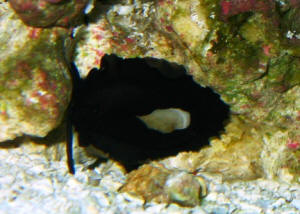 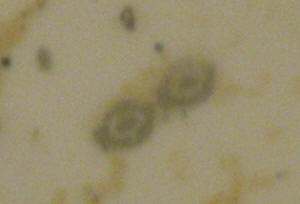 |
|
Re: What are these? 12/20/09
Happy Sunday Bob!
Thanks for your reply!
<Welcome Jamie>
I hope that Scutus Limpet multiplies in my tank. It is really
cute. I thought I saw a picture of it during my daily readings of
WWM several months ago but couldn't find it again. I see that
little guy out consistently around 10 PM after the metal halides
go out. It is a really neat creature.
<Ah yes>
The flukes from the AT, YUCK-O! Gives me goose bumps! I did not
do a formaldehyde dip, only pH and temp adjusted fresh water.
Should I do another dip? Either formaldehyde or fresh?
<Mmm... am wanting to choose my words carefully here. IF the
fish doesn't appear "too" malaffected, I would not
do the dip/bath. Likely these "Flukes" are digenetic...
have a complex life cycle (requiring other host/s)... and will
die out, do little harm; perhaps less than further handling the
fish/host itself... Unless this specimen "really"
itches and scratches a bunch, I would leave it be>
So a follow-up questions from our correspondence a week or so
ago...
All my fishes are in quarantine from that recent Ich outbreak.
They've all done well with Quinine Sulphate treatment of 10
days. It's been one week now and there is no signs of Ich
that I can see, some scratching behavior with my Atlantic Tang
and less with the Powder Blue. Should I be planning on
prophylactically treat with Quinine Sulphate again and/or should I
fresh water dip them prior to reintroduction to the DT?
<The latter>
Many thanks to YOU and your crew!
<Welcome>
It is so wonderful for me and many others to have someone who is
so knowledgeable to turn to. You and WWM make learning about
aquatic life fun and interactive. I have to honestly say that you
and your team have been THE
force for my success with reef keeping! Thank You Thank You Thank
YOU!
<Ahh! A pleasure to share, and indeed enlivening to realize
our useful help to others>
I've enclosed a picture of a few of the fishes who THANK YOU
for their lives! It's not the best of pictures but it shows
them 2 days after the 10 day QS treatment.
Best Regards to You!
Jamie
<And you, BobF>
|
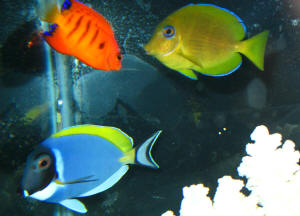 |
PraziPro, use, flukes Hello, I
recently purchased a Klein Butterfly, after being in a quarantine tank
for 2 weeks (with nothing apparently wrong) I added it to the display
tank. Now I think it may have flukes because it scratches against rocks
a lot. <Mmm, might I ask, how much is "a lot?". Most
fishes can/do "scratch some"...> Catching it would be very
difficult and would stress out it as well as others. The tank is a 180
g reef with many SPS and LPS and snails, no shrimp or crabs. PraziPro
states that it is safe for most aquarium inhabitants, but I am
skeptical. If left untreated will the flukes spread to others? <Mmm,
not often... turns out that most Trematodes are rather species, genus,
family specific> Are there any whole tank treatments? Thanks Mike
Winston <There are... but I urge patience here... Have another few
weeks go by... see if the "scratching" abates... not worth
the risk of killing all (and there may indeed be a bunch!) of your
Praziquantel sensitive life here. Bob Fenner>
Re: PraziPro, flukes 10/3/08
Thanks for the reply, well he is scratching enough to cause some scales
to come off, <! This is too much. Let's see... there are
several, okay a few reasons why fishes "scratch"...> no
bleeding but looks bad. I added some iodine to water thinking it might
help with wound. <Good> So my other fish include yellow and hippo
tang, swallowtail angel, blue throat trigger, dispar Anthias, Sixline
wrasse and some clowns. If flukes are not an issue to others I will
hold off any tank treatment, I was concerned others might be infected.
<A reasonable concern. I am more inclined to consider other
(Protozoan) possibilities... Still, at this juncture, I would not
"add" anything here... The fact that the range of fish life
you list is doing fine... leads me to wonder re other "itchy"
potentials... maybe this fish brushed up against something
irritating... BobF> Thanks again. Mike
It's Not A Fluke.. Or Is It? Good
Morning Scott, <Hi there!> Many thanks for your quick response.
After observing my fish further, it would appear that my blue face
angel has white, clear patches over his eyes. The patches seem to be
loose. This fish only seems to scratch his head from time to time, not
the rest of the body. <Hmm...> Do you think this could be
flukes????? I have seen some type of thread item on both eyes about
3-4mm in length and orange in colour (worm)? It's hard to get a
good look as he is shy at the best of time. <That is a distinct
possibility> My purple tang is also looking well fat (like never
before) even if I don't feed the tank for 24 hours. This is really
unusual. I'm now starting to lean towards some type of internal /
external worm in the system. <These fishes do occasionally come in
with internal parasites...> I used to have a powder blue tang that
passed away a year ago as each morning he would have what appeared to
be bad white spot but by the afternoon it would be totally gone. Anyway
the bug finally beat him and he died (poor thing). However after doing
a heap of research, it would appear that monogenetic flukes (I think
this is the correct name) can act in this way, leaving he host and
return early in the morning? Quite possible that it was never white
spot and monogenetic flukes (can look familiar to the naked eye). They
may have been lying dormant and ready to attack in force. Understand
that large angels are prone to this. Any ideas would be great as
I'm thinking about treating the tank again with Sterazin (by
Waterlife in the UK). Thanks again Che <Excellent insights and
research, Che. As you suggest, large angels are certainly prone to
contracting these creatures. I'd utilize a treatment course using a
Formalin-based product, if you suspect this to be the case. You really
want to use it as a dip, rather than an ongoing treatment, but it is
known to do the trick! You can find out more about treatment of flukes
on the WWM site. Good luck! Regards, Scott F>
Unwelcome Hitchers (External
Parasites?) Hello everyone. Hope all is well today. If I may,
I'd like to get your help IDing a problem a few of my fish are
having. <I'll try! Scott F. here today> I noticed a few days
ago that my Tomato Clown had a small, flat, almost translucent disk
shaped spot on it body, right behind the side fin so not near its gill.
It's actually left a mark on its fin as well, maybe an irritation
mark? <Could be> It looked like it was not fully attached, maybe
only at one point. Now he has a few more, one is underneath his body
and I can tell it is definitely not fully attached because it's
vertical to its body and the bottom of it moves back and forth with him
swimming/current. The fish's body on one side only also shows some
signs of like puckering marks or scar type marks that are a little
darker than his body but I think he always has these marks and not sure
if its related to these parasite-type things he has now - not lateral
line disease. I did some research on your site/web looking up parasites
but none fit this description, and also checked out isopods, but these
things do not look like a worm at all. Checked out flatworms too, but
what my fish have no color. <Curious> It's not Ich, been
there done that and can ID that bugger...I know the tank has a few
flatworms, as I've just recently spotted about 3 of them in my tank
and I got a positive ID off your website, awesome pix posted by the
way...It wouldn't be them attached to my fish right, don't they
just eat amphipods? <I don't believe that they'd be
attaching to fishes> (I'm gonna siphon them out anyway next time
I see 'em) What is on my fish remind me of a tiny shard of shiny
glass (like the little shiny things you find in granite?), very very
flat, like a piece of paper and circular in shape, the largest one is
maybe the width of a small BB and the rest are a little smaller. They
are almost translucent or clearish white. My coral beauty also has one
now as well as the Hawkfish. The fish all seem normal and not bothered
by it. They are eating as usual and swimming about. I don't see any
labored breathing or anything. My water quality is all within good
range. I just ran all numbers by you last month so I'll spare you
the details here, its all the same with the exception of my specific
gravity being higher than usual. Its normally 1.21-1.22 and it was
1.25. I'm very SLOWLY bringing that back within normal range (my
normal range that is) with some water changes with lower SG than
normal. I would like to figure out what these things are so I can do
something to get rid of them. I do remember that the tomato clown had
one of these marks way back, when we first got him (tank is only like 8
months old). It went away and I put it off to maybe he scratched
himself on something and it left a mark, then healed up...guessing I
was way wrong. I would try to get a pix but I don't think they
would show well as they are sort of clearish, plus I don't think
you can open the pix I send, as I tried once before. If these things
ring a bell with you, an ID would be great, if not, could steer me in
some direction as to what they MAY be I can try to do some more
research, and possibly try to match up a picture off the web of what it
may be. As usual, thanks a ton for taking the time to read/reply. This
site is an invaluable tool - thanks for sharing you knowledge... Jan
<Well, Jan, I'm thinking that you may be seeing some form of
monogenetic trematode, such as Benedina or other little nasties...Just
a guess. Typically, external parasites, flukes, and worms can be
knocked out with long-duration (like 30-60 minutes) of Formalin-based
remedies (at a bout 200mg/l concentration in saltwater). Net the
affected fishes and place them in a dedicated container for the
treatment. Worth a shot, IMO. Hope this helps. Regards, Scott
F>
Cloudy eye on yellow tang Quick
question I hope you can answer for me <Will try> I purchased a
yellow tang about 2 weeks ago and after several days he developed a
cloudy looking eye with a small bubble on it. Some of his fins also
seemed a little torn. I first thought it was due to new rocks I added
causing him to injure himself <More likely poor, diminished water
quality... perhaps related to the new rock> however I asked the man
at the store and he told me to dip him in freshwater which I did. When
I dipped him little white "discs" fell off of him. <Good
observation> He looks a little better now but I'm not sure what
else I should do. Your help would be appreciated ! The water has been
tested and is perfect in all aspects. The only other fish are 2 clown
fish . I also have 6 snails and am purchasing a cleaner shrimp today. I
feed them pellet crumbles and occasionally dried seaweed. Thank You
<Wish you had a small power microscope... could look at these discs,
maybe send a pic along... Very likely what you observed was flukes of
some sort... You can read re these, their avoidance, treatment on
WWM... use the search tool there, the indices. Bob Fenner>
|
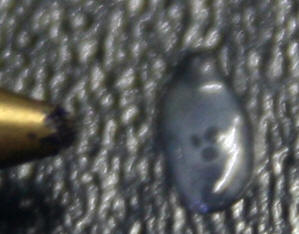 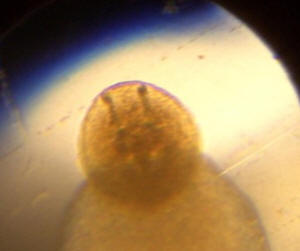
|
Sick French Angel, coral beauty dead ... flukes?
- 03/12/2006 At the beginning, I had an adult coral beauty; snow
flake eel, 6"; French Angel, 4"; Flame Hawk, 2". The
disease appears to start on the sides of the fish, then one eye becomes
opaque and swollen, weight loss despite good eating habits, fins become
frayed and finally, in the case of the coral beauty, death. Now a month
later and my French Angel is under the same attack. The ill fish swims
constantly against the current (my guess is that whatever it is, it is
also attacking the gills. Any ideas what this is? Suggested treatments?
Non-angel population seems fine. | <This last is an important
clue...> Thanks, Bob <... frightening... Could be a few things,
but you'll need to make a microscopic examination to be sure. I
suspect Trematodes here... A gill and body scraping of mucus... with or
w/o staining. You can read re their treatment on WWM. Bob
Fenner>
| Re: PB tang parasite? 1/31/07 Thanks Bob,
I've adjusted his diet to get him eating more Nori than Mysis,
and he's taking to it. I did a 2 gal water change using clean
water from my main tank and didn't add anything back in because
he seems to slowly be getting better. Any idea what kind of
parasite this is? Here's another pic. Thanks again <Would
take a scraping and a look/see under a dissection scope, but my
guess is on monogenetic fluke/s of some sort... Hence the
"de-wormer" rec. Do give this a read-over and
consideration. Bob Fenner> |
|
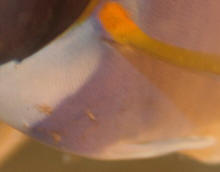
|
Localized fading skin color from parasites and
L. amboinensis behavior... Flukes? 9/26/07 Aloha, <Howzit?> I
have recently transplanted to the mainland from Hawaii. I mailed my
little family of fish (kept for 2-3 years previously) to our current
continental location. They were in a FO tank without live anything
except the bacterial additive I used to set them up initially. As you
know, Hawaii has very strict laws regulating the keeping of live rock
or live sand, etc. <Ah, yes> Now, my current set up is FOWLR and
some inverts. 46 gal bowfront (running for 3 months) Remora C HOT
skimmer 9 watt UV sterilizer Emperor 400 with carbon and Poly Filter (I
know it is not the best, but I already had it) Current 96 watt compact
fluorescents (10,000 K and actinic blue) 20-30 lbs mixed live/dead/Tufa
rock and fake ornaments (Some of the fish are very attached to their
ornaments and I don't have the heart to take it away) Thin layer of
mixed live and dead sand (approximately .75 inch) Old inhabitants moved
from Hawaii: Royal Gramma (Gramma loreto) Pajama Cardinal (Sphaeramia
nematoptera) Yellow Clown goby (Gobiodon okinawae) Two ocellaris clowns
(Amphiprion ocellaris) Since moving to the mainland the following are
new: Fire fish (Nemateleotris magnifica) <Mmm... social
animals...> 7-9 Peppermint shrimp (Lysmata rathbunae) One
"white antennae" Peppermint (Lysmata wurdemanni) Two cleaner
shrimp (Lysmata amboinensis) <... will be some attrition amongst
these shrimp with molting...> 25 assorted snails (Astrea, Nassarius,
and Cerith) <Too many...> Live rock and Tufa rock Water
parameters: Specific Gravity 1.0235 Temp. 78 degrees Fahrenheit Ph 8.2
Nitrites 0 Nitrates 0 Ammonia (unknown. I tested it then realized my
kit was for fresh water- time to get a new kit. I keep both fresh and
salt water tanks, but am newest to marine tanks, as you can tell.
I'm assuming the levels are OK since the fish and inverts are all
seemingly happy. <Likely so> Colors are vibrant and the shrimp
produce eggs like crazy. I add iodine for the shrimps and calcium for
the snails. Coralline algae seem to like it too. <Ah, good>
Here's the problem: I sometimes see the Clown Gobi and the male
ocellaris with clear/opaque non-pigmented spots. In the middle of these
"spots" sits a tiny white dot which I am assuming is a
parasite. These dots move around the body of the fish (I don't see
them actually moving, but the next day, they are in a different place
on the body of the fish). Sometimes it is on the tail, and sometimes
near the dorsal fin, etc. Sometimes they are not detectable at all.
When the little white parasite is gone, the color returns to the skin.
The fish, so far, get only one or two dots. Only the ocellaris scratch
(the female gets white dots without the blanching of the skin around
the parasite). I have not observed the parasites on the other fish. The
parasites do not seem to affect the fish in any noticeably negative
way. They all eat well (a variety of flake, Cyclop-eeze, frozen, table
shrimp, once in a great while they get live brine, and Selcon
periodically. I am nervous about this since I am still battling what I
think was velvet in another tank. <Do strictly maintain separate
gear... not even wet hands twixt...> It is now fallow with four
snails, a banded coral shrimp, one hermit crab, and a rock/sand crab
stow away (small sand colored burrowing crab, almost impossible to see
unless he moves). The sole remaining fish survivor is an IndoPacific
Sergeant Major damsel named "Nemo" because he is missing his
right fin. Nemo is tough and will probably recover. He has never
stopped eating "like a pig", and seems to be doing well in
quarantine. Sorry for the digression. My questions are:1) What do you
think this parasite is? (it acts most like the freshwater Chilodonella
as described by National Fish Pharmaceuticals <Mmm, no... you
wouldn't be able to see this... Perhaps a trematode... a Fluke of
some sort...> 2) What should I do about it? Will the shrimp take
care of the problem, or should I quarantine and treat the fish and let
the tank go fallow for 2 months? <Mmmm, you could try an
anthelminthic... My fave currently, Prazi... quantel, -pro...> I
would hate to lose these fish too, especially since they are family
pets (all have names), I feel very responsible for them since I am of
the thought that we should treat all the creatures we invite into our
homes with the best care possible. 3) If I need to treat the fish, what
should I use? Copper, Malachite green, something else? Are these
medications too strong for my little fish? <Yes...> I have not
seen the cleaner shrimp "clean" any of the fish. They are
relatively new. The larger cleaner shrimp seems aggressive. He/she will
lunge at the fish if they come too near. (It could be self defense
because when I put it in the tank, it unfortunately landed on the
clowns' favorite fake anemone. Needless to say, the clowns were
very upset and proceeded to attack the shrimp. I had to intervene at
this point and "shoo" the shrimp into the rocks.) It also
intimidates the peppermints and has taken over their favorite
"hang out". <Will eventually eat them...> Is this
normal behavior for a grouchy L. amboinensis? <Yes> Should I
consider putting it in with the banded coral shrimp in the
"velvet" tank? <Will likely be eaten there by the CBS>
I know banded coral shrimp can kill other shrimp. I have seen a large
one sever the arm off a smaller one, yet on the web I have seen
pictures of banded coral shrimp and L. amboinensis shrimp living in the
same tank. What do you suggest? <Another or larger system> One
other thought. Should I get a cleaner goby or two? <I do like
these...> Or will it suffer the same fate and get this parasite
also? <Perhaps so> Would the small fish in my tank be more likely
to let the cleaner gobies pick at them? <Mmm, no... not more than
the Lysmata spp.> Any guidance would be greatly appreciated. Mahalo
in advance, Lyn <Read re the Prazi... and consider a larger tank. A
hu'i hou! Bob Fenner>
Unknown parasite on Butterflyfish
please help. Flukes? 8/7/07 Hi, I Have a show size masked Heniochus
Butterflyfish in a 225gal fish only. He has small clear flatworm
looking parasites behind his gills and eating his fins. He is
constantly shaking I think trying to shake them off. What could this be
and how do I kill it out of my tank? <Likely flukes... a
pH-adjusted, slightly slower spg bath with formalin should do it here
if this is a digene (has a complex life cycle)...> My butterfly was
in my quarantine tank for a month and a week and showed no signs of any
thing. My quarantine tank is a 110L treated with CopperSafe. Out of
desperation I treated my main tank with copper <May have to treat
all with an organophosphate...> and I have still had to fresh water
dip my fish 3 times and they still keep coming back. <Need the
formalin...> The only other fish I have in there is a yellow tang
and a regal tang and they have never shown any signs of the parasite.
<Many Trematodes are quite species specific> I have turned off my
uv sterilizer recently, my skimmer is still running. My copper in the
aquarium is reading 1.5. They look like clear little flatworms
<Ahh!> and are moving around on that fish only mainly behind his
gills and on his fins. they have frayed the ends of all his fins.
Please Help <Please read here:
http://wetwebmedia.com/fshwrmdisfaqs.htm and the linked files above.
Bob Fenner>
| Parasite Help... and I mean HELP! Trematode plus
infested lg. SW sys. 7/10/07 Hi guys Great site! This is my
first question to your site, I feel need some professional help. My
blue face angel is sick, and Am not sure how to fix him. My Tank
Stats: First of all, I am writing from Australia. It is 10x2x2 ft
and has been set up for over four years now. Am a tang lover and I
have five tangs in there at the moment which are Blue Regal,
Sailfin, Purple, Yellow and Lipstick. I also have an Eiblii Angel,
Flame Angel, Premnas clown, three Zebra Darts, four Pyjama
Cardinals, Marine Betta, a Blue Spot Sting Ray and of course, the
Blue Face Angel. I do natural sea water changes of approximately
300 litres every two to three weeks. <Mmm, we should review your
protocol for the treatment, storage of the natural water...>
I've tested temp, salinity, ammonia, nitrite, nitrate, PH, KH
and all are fine except nitrate at about 10 ppm. The angel has been
in the tank now for about three weeks and he was not quarantined (I
know, my bad). When he first went into the tank he had a slightly
cloudy eye and was scratching on one side, right near the gill.
After a few days the cloudy eye seemed to clear and I thought he
was on the mend. Then (about a week and a half ago) I added the
Flame Angel who did and still seems healthy. The cloudy eye then
got worse on the Blue Face and I also noticed a small wound near
the anal fin (see attached). The tangs also started to scratch and
have been acting strangely, huddling in a corner of the tank. I
cant see any white spot on them however I have noticed the Yellow
Tang has a few missing bits out of his side fin and the Sailfin has
some scratches from the rocks. These fish have been healthy for
years. All fish are eating normally. I was advised by a local it
could be flukes and to give the Blue Face a fresh water bath with
RO water (temperature and PH adjusted) which I did for about two
minutes and in the water I found these clear little things which
seemed to fall off him (see attached). They kind of look like
scales or like a little contact lenses with three circles on them.
Are these a parasite? <Yes... the organism pictured at the tip
of the pen appears to be a Fluke... and trouble... you need to
determine whether this is a mono- or digenean (for means of
figuring out whether the life cycle can be easily broken), and if a
Monogenean, whether it is ovi- or vivi-parous... By microscopic
view of the rear attachment organ (the opisthoraptor)... the one
shown is inverted... To get a general idea of how to proceed
treatment wise. Small flukes can be dislodged via such FW dips, w/
or w/o ancillary materials added... Larger species of Monogeneans
can be very tough to dislodge... require extended,
high-concentration baths of formalin (e.g. 400 ppm) and many
species, weakened individuals can't take this... Skipping
ahead... as am sure you realize the extent of the non-quarantine
blunder here by now... you may be lucky and get away with use of an
organophosphate treatment here period... Many flukes are to degrees
species, genus, family specific in their host selection...>
Would this be the cause of the scratching, cloudy eye and would the
other fish have it? <Possibly, but you may well have a mixed
species parasitic situation... and yes, possibly> How can I get
rid of it, as I don't have a quarantine tank anymore? <You
don't need a QT, you need a treatment system... but as your
main system is infested, you will likely want to treat it... Not a
pleasant prospect...> If I kill them off the fish, are they
still living in the water and will they just re-infect?
<Bingo> Id be happy to treat the main tank with something as
long as it doesn't kill my sting ray and bubble tip anemones.
<...> Any advice and help would be greatly appreciated. Sorry
for the essay, but am trying to give you as much info as I can.
Thanks Brett & Leanne <My friend... Quarantine... use it,
believe in it, live it... You have some trying times ahead.
Cartilaginous fishes do not "like" acetylcholinesterase
inhibitors... I don't know exactly where to start or continue
with you here... IF you had time I'd have you buy and peruse Ed
Noga's "Fish Disease, Diagnosis & Treatment",
get/use a cheap microscope (likely the QX product line would do
here)... But your fishes may be all dead by then (a few days to
weeks)... At this point, do look around the Net, your large local
library, WWM under the terms: "Flukes",
"Trematodes", "Organophosphate" treatments...
Bob Fenner> |
|
 .jpg)
.jpg)
|
Re: Digenetic Flukes (Metacercaria)? Steven, I found this
info. If this is it should I not put the fish in my main tank and
instead take him back to the store? <I would not put him back in
your main tank, but I am not sure what is wrong with your fish,
yet.> Digenetic Flukes (Metacercaria): Typically seen in newly
imported fish and in two forms. Black spot is caught from snails that
release the Cercaria. Larval forms penetrate the skin and encyst in the
tissue and may be seen as red or black nodules. If eaten by a bird for
instance they then develop into adults. Sanguinicola disease passes
from fish to snail and then back as minute worms that live in the
fishes bloodstream. There they lay eggs that block up the blood vessels
which in turn causes Necrosis. As far as I know there is still no cure
for this problem. <I am not sure this is your (your fish's)
problem. -Steven Pro>
|
|

